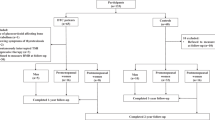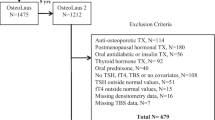Abstract
Purpose
The aim of this study is to assess the possible association between thyroid-stimulating hormone (TSH) and mortality in hip fracture patients.
Patients and methods
The study is based on a hip fracture database from Bispebjerg University Hospital (Copenhagen, Denmark). This database includes all hip fracture patients (ICD-10 codes DS720 (femoral neck), DS721 (pertrochanteric), and DS722 (subtrochanteric)) admitted to Bispebjerg Hospital from 1996 to 2012. From this database, we identified all surgically treated hip fracture patients aged > 60 years with available plasma TSH-measurements at admission.
Results
Of the 914 included patients (24% men and 76% women), 10.5% died within 30 days. At inclusion, 161 (17.6%) of the patients were hyperthyroid (TSH < 0.65 mIU/L), 58 (6.4%) were hypothyroid (TSH > 4.8 mIU/L), while 695 (76.0%) were euthyroid (0.65 < TSH < 4.80 mIU/L), p = 0.03. Mortality was significantly higher in the two higher quartiles of TSH [Q3 (13.0%) and Q4 (15.4%)] compared to the two lower quartiles [Q1 (7.4%) and Q2 (6.2%), p = 0.0003. After adjustment for age, sex and Charlson Comorbidity Index (CCI) in a Cox proportional hazard model, the risk of 30-day mortality continued to be increased in patients with TSH above the median as compared to patients with TSH below the median (HR 2.1 (1.4–3.3), p = 0.0006].
Conclusion
The study demonstrates increased 30-day mortality in surgically treated hip fracture patients with plasma TSH levels above the median (1.41 mIU/L) at admission, even after adjusting for age, sex and CCI.



Similar content being viewed by others
References
Jantzen C, Madsen CM, Lauritzen JB, Jørgensen HL. Temporal trends in hip fracture incidence, mortality, and morbidity in Denmark from 1999 to 2012. Acta Orthop. 2018;89(2):170–6.
Haentjens P, Magaziner J, Colón-Emeric CS, Vanderschueren D, Milisen K, Velkeniers B, et al. Meta-analysis: excess mortality after hip fracture among older women and men. Ann Intern Med. 2010;152(6):380–90.
Petersen MB, Jørgensen HL, Hansen K, Duus BR. Factors affecting postoperative mortality of patients with displaced femoral neck fracture. Injury. 2006;37:705–11.
Incalzi RA, Capparella O, Gemma A, Camaioni D, Sanguinetti C, Carbonin PU. Predicting in-hospital mortality after hip fracture in elderly patients. J Trauma. 1994;36(1):79–82.
Dennison E, Mohamed MA, Cooper C. Epidemiology of osteoporosis. Rheum Dis Clin North Am. 2006;32(4):617–29.
Santesso N, Carrasco-Labra A, Brignardello-Petersen R. Hip protectors for preventing hip fractures in older people. Cochrane Database Syst Rev. 2014;. https://doi.org/10.1002/14651858.CD001255.pub4.
Seeman E, Delmas PD. Bone quality—the material and structural basis of bone strength and fragility. N Engl J Med. 2006;354(21):2250–61.
Martineau P, Leslie WD. Trabecular bone score (TBS): Method and applications. Bone. 2017;2017(104):66–72.
Tranquilli Leali P, Doria C, Zachos A, Ruggiu A, Milia F, Barca F. Bone fragility: current reviews and clinical features. Clin Cases Miner Bone Metab. 2009;6(2):109–13.
Briot K, Geusens P, Em Bultink I, Lems WF, Roux C. Inflammatory diseases and bone fragility. Osteoporos Int. 2017;28(12):3301–14.
Sheu A, Diamond T. Secondary osteoporosis. Aust Prescr. 2016;39(3):85–7.
Tsevis K, Trakakis E, Pergialiotis V, Alhazidou E, Peppa M, Chrelias C, et al. The influence of thyroid disorders on bone density and biochemical markers of bone metabolism. Horm Mol Biol Clin Investig. 2018;35(1):20180039.
Abrahamsen B, Jørgensen HL, Laulund AS, Nybo M, Brix TH, Hegedüs L. Low serum thyrotropin level and duration of suppression as a predictor of major osteoporotic fractures—the OPENTHYRO register cohort. J Bone Miner Res. 2014;29(9):2040–50.
Hu F, Jiang C, Shen J, Tang P, Wang Y. Preoperative predictors for mortality following hip fracture surgery: a systematic review and meta-analysis. Injury. 2012;43(6):676–85.
Kannegaard PN, van der Mark S, Eiken P, Abrahamsen B. Excess mortality in men compared with women following a hip fracture National analysis of comedications, comorbidity and survival. Age Ageing. 2010;39(2):203–9.
Norring-Agerskov D, Laulund AS, Lauritzen JB, Duus BR, van der Mark S, Mosfeldt M, et al. Metaanalysis of risk factors for mortality in patients with hip fracture. Dan Med J. 2013;60(8):A4675.
Mosfeldt M, Pedersen OB, Riis T, Worm HO, Mark SV, Jorgensen HL, et al. Value of routine blood tests for prediction of mortality risk in hip fracture patients. Acta Orthop. 2012;83(1):31–5.
Norring-Agerskov D, Madsen CM, Abrahamsen B, Riis T, Pedersen OB, Jørgensen NR, et al. Hyperkalemia is associated with increased 30-day mortality in hip fracture patients. Calcif Tissue Int. 2017;101(1):9–16.
Tinning CG, Cochrane LA, Singer BR. Analysis of hyponatraemia associated post-operative mortality in 3897 hip fracture patients. Injury. 2015;46(7):1328–32.
Madsen CM, Jantzen C, Lauritzen JB, Abrahamsen B, Jorgensen HL. Hyponatremia and hypernatremia are associated with increased 30-day mortality in hip fracture patients. Osteoporos Int. 2015;27(1):297–404.
Hagino T, Ochiai S, Watanabe Y, Senga S, Saito M, Takayama Y, et al. Hyponatremia at admission is associated with in-hospital death in patients with hip fracture. Arch Orthop Trauma Surg. 2013;133(4):507–11.
Kovar FM, Endler G, Wagner OF, Jaindl M. Basal haemoglobin levels as prognostic factor for early death in elderly patients with a hip fracture—a 20 year observation study. Injury. 2015;46(6):1018–22.
Praetorius K, Madsen CM, Abrahamsen B, Jorgensen HL, Lauritzen JB, Laulund ASB. Low Levels of hemoglobin at admission are associated with increased 30-day mortality in patients with hip fracture. Geriatr Orthop Surg Rehabil. 2016;7(3):1–6.
Kim BG, Lee YK, Park HP, Sohn HM, Oh AY, Jeon YT, et al. C-reactive protein is an independent predictor for 1-year mortality in elderly patients undergoing hip fracture surgery: a retrospective analysis. Medicine (Baltimore). 2016;95(43):e5152.
Norring-Agerskov D, Bathum L, Pedersen OB, Abrahamsen B, Lauritzen JB, Jørgensen NR, et al. Biochemical markers of inflammation are associated with increased mortality in hip fracture patients: the Bispebjerg Hip Fracture Biobank. Aging Clin Exp Res. 2019;31(12):1727–34.
Pajulammi HM, Luukkaala TH, Pihlajamäki HK, Nuotio MS. Decreased glomerular filtration rate estimated by 2009 CKD-EPI equation predicts mortality in older hip fracture population. Injury. 2016;47(7):1536–42.
Stenqvist C, Madsen CM, Riis T, Jorgensen HL, Duus BR, Lauritzen JB, et al. Orthogeriatric service reduces mortality in patients with hip fracture. Geriatr Orthop Surg Rehabil. 2016;7(2):67–73.
Schmidt M, Pedersen L, Sørensen HT. The Danish civil registration system as a tool in epidemiology. Eur J Epidemiol. 2014;29(8):541–9.
Lynge E, Sandegaard JL, Rebolj M. The Danish national patient register. Scand J Public Health. 2011;39:30–3.
Charlson ME, Pompei P, Ales KL, MacKenzie CR. A new method of classifying prognostic comorbidity in longitudinal studies: development and validation. J Chronic Dis. 1987;40(5):373–83.
Rosenfarb J, Sforza N, Rujelman R, Morosan Allo Y, Parisi C, Blanc E, et al. Relevance of TSH evaluation in elderly in-patients with non-thyroidal illness. J Endocrinol Invest. 2019;42(6):667–71.
Ling XW, Sen HT, Koh JSB, Wong MK, Ng ACM. Preoperative thyroid dysfunction predicts 30-day postoperative complications in elderly patients with hip fracture. Geriatr Orthop Surg Rehabil. 2013;4(2):43–9.
Buller LT, Rosas S, Sabeh KG, Roche MW, McLawhorn AS, Barsoum WK. Hypothyroidism increases 90-day complications and costs following primary total knee arthroplasty. J Arthroplasty. 2018;33(4):1003–7.
Tan TL, Rajeswaran H, Haddad S, Shahi A, Parvizi J. Increased risk of periprosthetic joint infections in patients with hypothyroidism undergoing total joint arthroplasty. J Arthroplasty. 2016;31(4):868–71.
Ehrenkranz J, Bach PR, Snow GL, Schneider A, Lee JL, Ilstrup S, et al. Circadian and circannual rhythms in thyroid hormones: determining the TSH and free T4 reference intervals based upon time of day, age, and sex. Thyroid. 2015;25(8):954–61.
Author information
Authors and Affiliations
Corresponding author
Ethics declarations
Conflict of interest
Etienne Rapacki, Jes B. Lauritzen, Christian M. Madsen, Henrik L. Jørgensen and Debbie Norring-Agerskov declare that they have no conflict of interest.
Rights and permissions
About this article
Cite this article
Rapacki, E., Lauritzen, J.B., Madsen, C.M. et al. Thyroid-stimulating hormone (TSH) is associated with 30-day mortality in hip fracture patients. Eur J Trauma Emerg Surg 47, 1081–1087 (2021). https://doi.org/10.1007/s00068-019-01260-9
Received:
Accepted:
Published:
Issue Date:
DOI: https://doi.org/10.1007/s00068-019-01260-9




